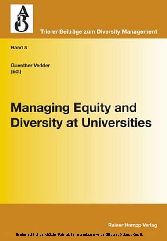Suchen und Finden
Service
Managing Equity and Diversity at Universities
Guenther Vedder (Ed.)
Verlag Rainer Hampp Verlag, 2006
ISBN 9783866181182 , 176 Seiten
Format PDF, OL
Kopierschutz Wasserzeichen
Equity and Diversity at Universities in Switzerland (S. 150-151)
Equity and Diversity at Swiss Universities In this chapter, I will provide a brief overview of the "gender and diversity landscape" at Swiss universities. I will begin by presenting some information about the higher education system in Switzerland and looking at the relevance of gender and diversity management. I will then discuss in greater detail the situation of equal opportunity initiatives at Swiss universities. There is a special focus on the "Federal Programme for Equal Opportunities of Women and Men at Swiss Universities", as it is the broadest programme in terms of scale and scope for Swiss universities. Subsequently, I will briefly address the situation at the Swiss Institutes for Technology, the Universities of Applied Sciences, the Swiss National Foundation and provide an overview of the closely related topic of promoting the development of Gender Studies in Switzerland.
1.1 Higher Education in Switzerland
When discussing topics concerning higher education in Switzerland, one should bear in mind that there are three types of institutions of higher education in Switzerland’s federalist system: First, the two Federal Institutes of Technology (ETH Zurich and EPFL Lausanne), which are funded and controlled by the Swiss Confederation, second, the universities, which are predominantly under autonomous cantonal control. Although the federal government does partly fund the universities, it may only intervene indirectly via the granting of specific project money, and third, the universities of applied sciences. Here, the responsibilities and funding situations are not as clearcut. In the areas of economics, technology and design, funding is provided by the Swiss Confederation, while for other subject areas, it might also be provided at the cantonal level.
The situation is highly heterogeneous, as are the actions and measures taken. Thus, when considering "management" strategies at Swiss Universities, this heterogeneity has to be taken into account. The federal system is also reflected by the legal framework of equal opportunity measures. Since 1981, women and men in Switzerland have had the same constitutional rights to equal opportunity, equal status and equal payment. Furthermore, "the legislator must remove any sexual inequalities, in particular with regard to family, work and education." (Brander 1995) However, as the universities are subject to cantonal law, the constitutional right has to be transferred first to cantonal law and then to university law ("Universitätsgesetz") in order to bring the law into force. Indeed, this leads to a very heterogeneous situation regarding the institutionalisation of measures, for instance in the area of equal opportunity offices, as described later in this chapter.
The only way in which the federal government can influence the universities` policies is via the launching of directly financed projects such as the "Federal Programme for Equal Opportunities of Women and Men at Swiss Universities", implemented for the first time in 2000. Therefore, I will discuss the situation and measures for all three types of institutions separately. Where "higher education institutions" in general are mentioned, it can be assumed that all three types apply.
1.2 Diversity at Swiss Universities
With regard to diversity, it is worthwhile to consider the factors of gender, language, nationality and class, although these are not particularly widely discussed. Nowadays, 20% of school-leavers in Switzerland enrol in a higher education programme.



